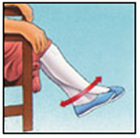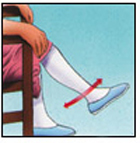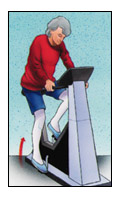Exercises - Total Knee
Early Postoperative Exercises
These exercises are important for increasing circulation to your legs and feet to prevent blood clots. They also are important to strengthen muscles and to improve your hip movement. You may begin these exercises in the recovery room shortly after surgery. It may feel uncomfortable at first but these exercises will speed your recovery and reduce your postoperative pain. These exercises should be done as you lie on your back with your legs spread slightly apart.
Quad Sets - Tighten your thigh muscle. Try to straighten your knee. Hold for 5 to 10 seconds. Repeat this exercise approximately 10 times during a two minute period, rest one minute and repeat. Continue until your thigh feels fatigued.
 Straight Leg Raises - Tighten your thigh muscle with your knee fully straightened on the bed. As your thigh muscle tightens, lift your leg several inches off the bed. Hold for 5 to 10 seconds. Slowly lower. Repeat until your thigh feels fatigued.
Straight Leg Raises - Tighten your thigh muscle with your knee fully straightened on the bed. As your thigh muscle tightens, lift your leg several inches off the bed. Hold for 5 to 10 seconds. Slowly lower. Repeat until your thigh feels fatigued.Ankle Pumps - Slowly push your foot up and down. Do this
 exercise several times as often as every 5 or 10 minutes. This exercise can begin immediately after surgery and continue until you are fully recovered.
exercise several times as often as every 5 or 10 minutes. This exercise can begin immediately after surgery and continue until you are fully recovered.Knee Straightening Exercises - Place a small rolled towel
 just above your heel so that it is not touching the bed. Tighten your thigh. Try to fully straighten your knee and to touch the back of your knee to the bed. Hold fully straightened for five to 10 seconds. Repeat until your thigh feels fatigued.
just above your heel so that it is not touching the bed. Tighten your thigh. Try to fully straighten your knee and to touch the back of your knee to the bed. Hold fully straightened for five to 10 seconds. Repeat until your thigh feels fatigued.Bed-Supported Knee Bends - Slide your heel toward your
 buttocks, bending your knee and keeping your heel on the bed. Do not let your knee roll inward.
buttocks, bending your knee and keeping your heel on the bed. Do not let your knee roll inward.Sitting Supported Knee Bends - While sitting at bedside or
 in a chair with your thigh supported, place your foot behind the heel of your operated knee for support. Slowly bend your knee as far as you can. Hold your knee in this position
for 5 to 10 seconds. Repeat several times until your leg feels fatigued or until you can completely bend your knee.
in a chair with your thigh supported, place your foot behind the heel of your operated knee for support. Slowly bend your knee as far as you can. Hold your knee in this position
for 5 to 10 seconds. Repeat several times until your leg feels fatigued or until you can completely bend your knee. Sitting Unsupported Knee Bends - While sitting at bedside or in a chair
 with your thigh supported, bend your knee as far as you can until your foot rests on the floor. With your foot lightly resting on the floor, slide your upper body forward in the chair to increase your knee bend. Hold for 5 to 10 seconds. Straighten your knee fully. Repeat several times until your leg feels fatigued or until you can completely bend your knee.
with your thigh supported, bend your knee as far as you can until your foot rests on the floor. With your foot lightly resting on the floor, slide your upper body forward in the chair to increase your knee bend. Hold for 5 to 10 seconds. Straighten your knee fully. Repeat several times until your leg feels fatigued or until you can completely bend your knee. EARLY ACTIVITY
Soon after your surgery, you will begin to walk short distances in your hospital room and perform everyday activities. This early activity aids your recovery and helps your knee regain its strength and movement.
 Walking - Proper walking is the best way to help your knee recover. At first, you will walk with a walker or crutches. Your surgeon or therapist will tell you how much weight to put on your leg.
Walking - Proper walking is the best way to help your knee recover. At first, you will walk with a walker or crutches. Your surgeon or therapist will tell you how much weight to put on your leg. Stand comfortably and erect with your weight evenly balanced on your walker or crutches. Advance your walker or crutches a short distance; then reach forward with your operated leg with your knee straightened so the heel of your foot touches the floor first. As you move forward, your knee and ankle will bend and your entire foot will rest evenly on the floor. As you complete the step, your toe will lift off the floor and your knee and hip will bend so that you can reach forward for your next step. Remember, touch your heel first, then flatten your foot, then lift your toes off the floor.
Walk as rhythmically and smooth as you can. Don't hurry. Adjust the length of your step and speed as necessary to walk with an even pattern. As your muscle strength and endurance improve, you may spend more time walking. You will gradually put more weight on your leg. You may use a cane in the hand opposite your surgery and eventually walk without an aid.
When you can walk and stand for more than 10 minutes and your knee is strong enough so that you are not carrying any weight on your walker or crutches (often about two to three weeks after your surgery), you can begin using a single crutch or cane. Hold the aid in the hand opposite the side of your surgery. You should not limp or lean away from your operated knee.

Stair climbing is an excellent strengthening and endurance activity. Do not try to climb steps higher than the standard height (7 inches) and always use a handrail for balance. As you become stronger and more mobile, you can begin to climb stairs foot over foot.
Stair Climbing and Descending - The ability to go up and down stairs requires strength and flexibility. At first, you will need a handrail for support and will be able to go only one step at a time. Always lead up the stairs with your good knee and down the stairs with your operated knee. Remember, "up with the good" and "down with the bad." You may want to have someone help you until you have regained most of your strength and mobility.
Advanced Exercises and Activities - Once you have regained independence for short distances and a few steps, you may increase your activity. The pain of your knee problems before
 surgery and the pain and swelling after surgery have weakened your knee. A full recovery will take many months. The following exercises and activities will help you recover fully.
surgery and the pain and swelling after surgery have weakened your knee. A full recovery will take many months. The following exercises and activities will help you recover fully. Standing Knee Bends - Standing erect with the aid of a walker or crutches, lift your thigh and bend your knee as much as you can. Hold for 5 to 10 seconds. Then straighten your knee, touching the floor with your heel first. Repeat several times until fatigued.
Assisted Knee Bends - Lying on your back, place a folded towel over your operated knee and drop the towel to your foot. Bend your knee and apply gentle pressure through the towel to increase the bend. Hold for 5 to 10 seconds; repeat several times until fatigued.
Knee Exercises with Resistance - You can place light weights around your ankle and repeat any of the above exercises. These resistance exercises usually can begin four to six weeks after your surgery. Use one- to two-pound weights at first; gradually increase the weight as your strength returns. (Inexpensive wrap-around ankle weights with Velcro straps can be purchased at most sporting goods stores.)

Exercycling - Exercising is an excellent activity to help you regain muscle strength and knee mobility. At first, adjust the seat height so that the bottom of your foot just touches the pedal with your knee almost straight. Peddle backward at first. Ride forward only after a comfortable cycling motion is possible backwards.
As you become stronger (at about four to six weeks) slowly increase the tension on the exercycle. Exercycle for 10 to 15 minutes twice a day, gradually build up to 20 to 30 minutes, three or four times a week.
Pain or Swelling after Exercise - You may experience knee pain or swelling after exercise or activity. You can relieve this by elevating your leg and applying ice wrapped in a towel. Exercise and activity should consistently improve your strength and mobility. If you have any questions or problems, contact your orthopaedic surgeon or physical therapist.